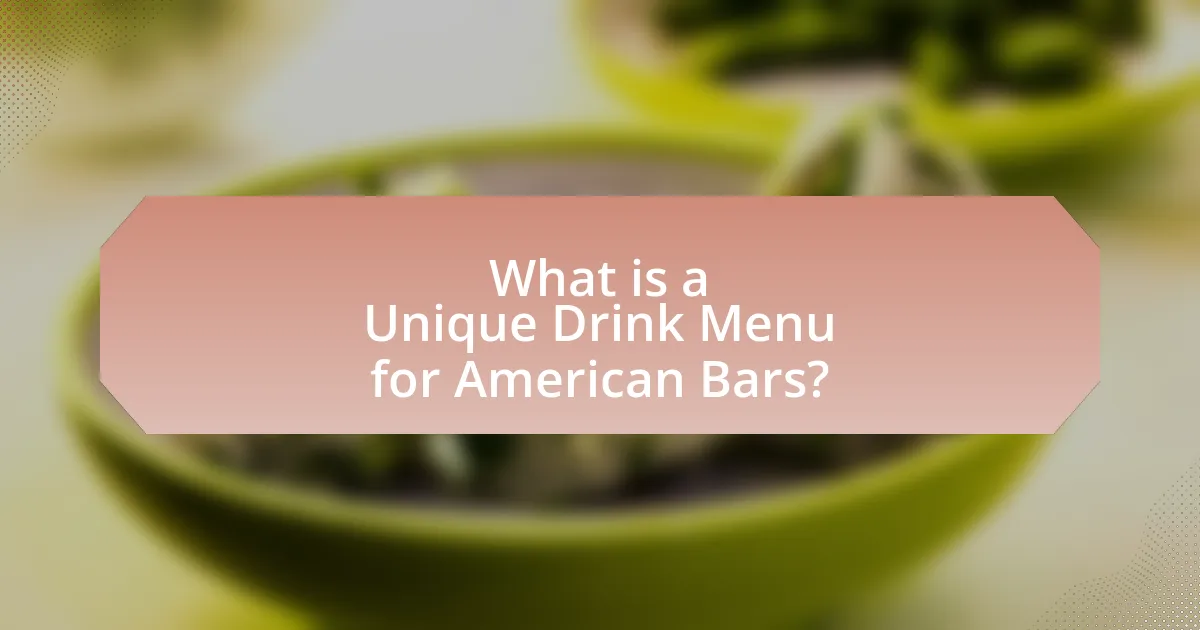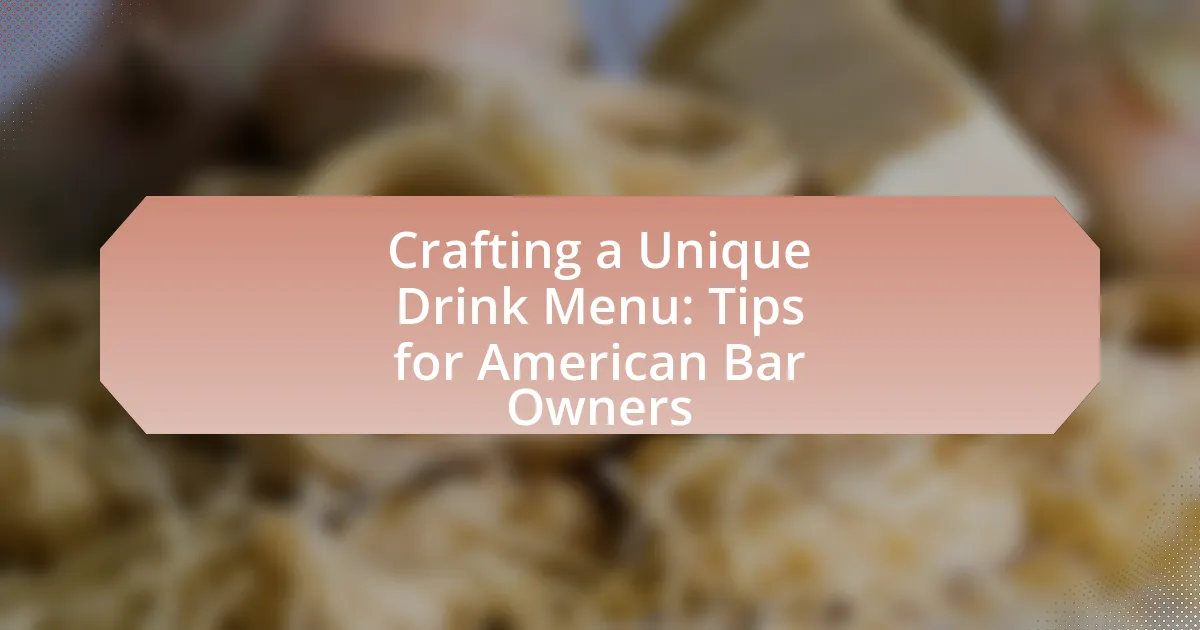Crafting a unique drink menu is essential for American bar owners to differentiate their establishments in a competitive market. This article explores the components that contribute to a distinctive drink menu, including innovative cocktails, local ingredients, and thematic coherence. It highlights the importance of customer feedback in shaping menu offerings and discusses strategies for marketing unique drinks through social media and events. Additionally, the article emphasizes the role of seasonal ingredients and local culture in enhancing the overall bar experience, ultimately driving customer satisfaction and loyalty.

What is a Unique Drink Menu for American Bars?
A unique drink menu for American bars features innovative cocktails, local craft beers, and signature drinks that reflect the bar’s identity and cater to customer preferences. This menu often includes seasonal ingredients, artisanal spirits, and creative presentations to enhance the drinking experience. For instance, bars may incorporate regional flavors or cultural influences, such as a bourbon-based cocktail with local fruit or a twist on a classic drink. The uniqueness is further established by offering exclusive house-made mixers or infusions, which can differentiate the bar from competitors and attract a diverse clientele.
How does a unique drink menu enhance the bar experience?
A unique drink menu enhances the bar experience by offering customers distinctive options that elevate their enjoyment and engagement. This variety encourages exploration and conversation, making patrons feel more connected to the bar’s identity. Research indicates that bars with innovative drink menus can increase customer retention by up to 30%, as unique offerings create memorable experiences that patrons are likely to share with others. Additionally, a well-curated drink menu can reflect local culture and trends, further enriching the overall atmosphere and appeal of the establishment.
What elements contribute to a drink menu’s uniqueness?
A drink menu’s uniqueness is primarily influenced by its selection of ingredients, signature cocktails, presentation style, and thematic coherence. The choice of ingredients can include local or rare spirits, unique mixers, and fresh garnishes that reflect regional flavors or trends. Signature cocktails, which are often house specialties, can set a bar apart by showcasing creativity and innovation. Presentation style, including glassware and garnishing techniques, enhances the visual appeal and overall experience. Lastly, thematic coherence ties the drink menu to the bar’s concept, creating a cohesive identity that resonates with patrons. These elements collectively contribute to a drink menu’s distinctiveness, making it memorable and appealing to customers.
How does customer feedback influence drink menu creation?
Customer feedback significantly influences drink menu creation by providing insights into customer preferences and trends. Bars analyze feedback through surveys, social media interactions, and direct customer comments to identify popular flavors, ingredients, and drink styles. For instance, a study by the National Restaurant Association found that 70% of consumers are more likely to order a drink if they see it recommended by others, highlighting the impact of customer opinions on menu decisions. By incorporating this feedback, bar owners can tailor their offerings to meet customer desires, ultimately enhancing customer satisfaction and driving sales.
Why is it important for American bar owners to craft a unique drink menu?
It is important for American bar owners to craft a unique drink menu because it differentiates their establishment in a competitive market. A distinctive drink menu attracts customers seeking novel experiences, which can lead to increased foot traffic and customer loyalty. According to a study by the National Restaurant Association, 70% of consumers are more likely to visit a bar that offers unique or specialty drinks. This indicates that a well-curated drink menu not only enhances the bar’s appeal but also contributes to higher sales and profitability.
What competitive advantages does a unique drink menu provide?
A unique drink menu provides competitive advantages by attracting diverse customers and enhancing brand differentiation. Establishments with distinctive offerings can create a memorable experience that sets them apart from competitors, leading to increased customer loyalty. For instance, a study by the National Restaurant Association found that 70% of consumers are more likely to visit a restaurant with unique beverage options. This indicates that a unique drink menu not only draws in patrons but also encourages repeat visits, ultimately boosting sales and profitability.
How can a unique drink menu reflect local culture and trends?
A unique drink menu can reflect local culture and trends by incorporating regional ingredients, traditional recipes, and popular flavor profiles that resonate with the community. For instance, using locally sourced spirits or seasonal fruits can highlight the area’s agricultural heritage, while cocktails inspired by local festivals or historical events can create a sense of place. Additionally, trends such as craft cocktails or health-conscious options can align with the evolving preferences of the local demographic, showcasing the bar’s responsiveness to current consumer interests. This approach not only enhances the authenticity of the drink offerings but also fosters a connection between patrons and their local culture.

What are the key components of crafting a unique drink menu?
The key components of crafting a unique drink menu include creativity, theme consistency, ingredient quality, and customer engagement. Creativity allows for innovative drink combinations that stand out, while theme consistency ensures that the menu aligns with the bar’s overall concept, enhancing the customer experience. Ingredient quality is crucial, as using fresh and high-quality components can elevate the taste and appeal of the drinks. Customer engagement, through interactive elements like customizable drinks or seasonal specials, fosters a connection with patrons and encourages repeat visits. These components collectively contribute to a memorable and distinctive drink menu that attracts and retains customers.
How do bar themes influence drink menu design?
Bar themes significantly influence drink menu design by dictating the style, ingredients, and presentation of beverages offered. For instance, a tiki bar theme typically features tropical ingredients like rum and fruit juices, while a speakeasy theme may emphasize classic cocktails with a vintage presentation. This alignment ensures that the drink menu resonates with the overall atmosphere and concept of the bar, enhancing customer experience and engagement. Research indicates that themed environments can increase customer satisfaction and loyalty, as patrons are more likely to enjoy a cohesive experience that reflects the bar’s identity.
What types of themes are popular among American bars?
Popular themes among American bars include sports, retro, tiki, and speakeasy. Sports bars focus on showcasing live games and memorabilia, creating an energetic atmosphere for fans. Retro-themed bars often feature vintage decor and music from past decades, appealing to nostalgia. Tiki bars emphasize tropical decor and cocktails, offering an exotic experience. Speakeasy bars recreate the ambiance of Prohibition-era establishments, often with hidden entrances and craft cocktails. These themes cater to diverse customer preferences and enhance the overall bar experience.
How can themes be integrated into drink descriptions?
Themes can be integrated into drink descriptions by aligning the ingredients, presentation, and flavor profiles with a specific concept or narrative. For example, a tropical theme can be reflected in a drink description that highlights fresh fruits, vibrant colors, and exotic spices, creating an immersive experience for the customer. This approach not only enhances the appeal of the drink but also reinforces the overall atmosphere of the bar, making it memorable. By using descriptive language that evokes sensory experiences related to the theme, bar owners can effectively engage customers and encourage them to explore the menu further.
What role do seasonal ingredients play in a unique drink menu?
Seasonal ingredients are crucial in creating a unique drink menu as they enhance flavor profiles, promote freshness, and reflect local agricultural cycles. Utilizing seasonal produce allows bars to offer innovative cocktails that change throughout the year, keeping the menu dynamic and engaging for customers. For instance, using fresh berries in summer cocktails or warming spices in winter drinks not only elevates taste but also aligns with consumer preferences for freshness and sustainability. This approach can lead to increased customer satisfaction and loyalty, as patrons appreciate the creativity and quality associated with seasonal offerings.
How can bar owners source local and seasonal ingredients?
Bar owners can source local and seasonal ingredients by establishing relationships with local farmers and producers. This direct connection allows bar owners to access fresh, high-quality ingredients that are in season, ensuring the menu reflects the local agricultural landscape. Additionally, participating in farmers’ markets and joining local food co-ops can provide bar owners with a variety of seasonal options. Research indicates that sourcing locally not only supports the community but also enhances the flavor profile of drinks, as ingredients are harvested at their peak ripeness.
What are the benefits of using seasonal ingredients in cocktails?
Using seasonal ingredients in cocktails enhances flavor, freshness, and sustainability. Seasonal ingredients are often at their peak ripeness, resulting in more vibrant and complex flavors that elevate the overall drinking experience. Additionally, utilizing local and seasonal produce supports local farmers and reduces the carbon footprint associated with transportation. For example, a study by the University of California found that seasonal fruits and vegetables can have higher nutrient content, which contributes to healthier cocktails. This practice not only creates unique and memorable drinks but also aligns with the growing consumer preference for sustainable and locally sourced products.

How can bar owners effectively market their unique drink menu?
Bar owners can effectively market their unique drink menu by leveraging social media platforms to showcase visually appealing images and videos of their drinks. Engaging content, such as behind-the-scenes preparation or mixology tutorials, can attract potential customers and create buzz around the menu. According to a study by Sprout Social, 70% of consumers are more likely to purchase a product after seeing it on social media, highlighting the effectiveness of this strategy. Additionally, hosting themed events or tastings can create an immersive experience that encourages patrons to try the unique offerings, further enhancing visibility and customer engagement.
What strategies can be used to promote a unique drink menu?
To promote a unique drink menu, bar owners can utilize social media marketing, host tasting events, and collaborate with local influencers. Social media platforms like Instagram and Facebook allow for visually appealing posts that showcase the unique drinks, attracting potential customers. Hosting tasting events provides an interactive experience where patrons can sample and provide feedback on the drinks, fostering community engagement. Collaborating with local influencers can expand reach, as their endorsements can introduce the drink menu to a broader audience. According to a study by the National Restaurant Association, 70% of consumers are influenced by social media when choosing dining options, highlighting the effectiveness of these strategies.
How can social media be leveraged for drink menu marketing?
Social media can be leveraged for drink menu marketing by creating visually appealing content that showcases unique drink offerings and engages the audience. Platforms like Instagram and Facebook allow bar owners to post high-quality images and videos of their drinks, which can attract potential customers and encourage sharing. According to a study by Sprout Social, 70% of consumers are more likely to make a purchase after seeing a brand’s social media post. Additionally, utilizing targeted ads can reach specific demographics, increasing visibility among potential patrons. Engaging with followers through polls, contests, and user-generated content can further enhance customer interaction and loyalty, driving traffic to the bar.
What role do events and tastings play in marketing a drink menu?
Events and tastings serve as crucial marketing tools for a drink menu by creating direct engagement opportunities with customers. These activities allow patrons to experience the flavors and unique offerings of the drink menu firsthand, fostering a deeper connection to the brand. According to a study by the National Restaurant Association, 70% of consumers are more likely to try new beverages when they are part of an event or tasting experience. This statistic underscores the effectiveness of such events in driving sales and enhancing customer loyalty. Additionally, events can generate buzz and word-of-mouth promotion, further amplifying the reach of the drink menu.
How can bar owners gather and utilize customer feedback on their drink menu?
Bar owners can gather and utilize customer feedback on their drink menu by implementing surveys, comment cards, and digital feedback tools. Surveys can be distributed physically or electronically, allowing customers to rate drinks and provide comments, which helps identify popular items and areas for improvement. Comment cards placed on tables or at the bar encourage immediate feedback, while digital tools like social media polls or dedicated feedback apps enable real-time responses. According to a study by the National Restaurant Association, 70% of customers are more likely to return to a restaurant that actively seeks their feedback, demonstrating the importance of engaging customers in the menu development process. By analyzing this feedback, bar owners can adjust their offerings to better meet customer preferences, ultimately enhancing customer satisfaction and loyalty.
What methods can be used to collect customer feedback?
Surveys and questionnaires are effective methods to collect customer feedback. These tools can be distributed online or in-person, allowing bar owners to gather specific insights about customer preferences and experiences. According to a study by SurveyMonkey, 90% of consumers are willing to provide feedback when asked, highlighting the importance of actively seeking customer opinions. Other methods include comment cards, social media polls, and direct interviews, which can also yield valuable information about customer satisfaction and suggestions for menu improvements.
How can feedback be analyzed to improve the drink menu?
Feedback can be analyzed to improve the drink menu by systematically collecting customer opinions and preferences through surveys, reviews, and direct interactions. This data can then be categorized to identify trends, such as popular ingredients or drink styles, allowing bar owners to adjust their offerings accordingly. For instance, a study by the National Restaurant Association found that 70% of consumers are influenced by menu variety, indicating that understanding customer feedback can lead to a more appealing drink selection. By implementing changes based on this analysis, bar owners can enhance customer satisfaction and potentially increase sales.
What are some best practices for maintaining a unique drink menu?
To maintain a unique drink menu, bar owners should regularly innovate by incorporating seasonal ingredients and local flavors. This approach not only keeps the menu fresh but also appeals to customers seeking new experiences. For instance, using locally sourced fruits and herbs can create signature cocktails that reflect the region’s culture, enhancing customer engagement. Additionally, conducting regular menu reviews and soliciting customer feedback can help identify popular items and areas for improvement, ensuring the menu evolves with customer preferences. Implementing these practices can lead to a distinctive and appealing drink menu that stands out in a competitive market.
How often should a drink menu be updated?
A drink menu should be updated at least every season to reflect changing trends and seasonal ingredients. Seasonal updates allow bar owners to incorporate fresh produce and adapt to consumer preferences, which can enhance customer experience and drive sales. Research indicates that menus that change regularly can increase customer interest and repeat visits, as patrons are more likely to try new offerings.
What common pitfalls should bar owners avoid when crafting their drink menu?
Bar owners should avoid overcomplicating their drink menu with too many options, as this can overwhelm customers and dilute the brand identity. A concise menu allows for better focus on signature drinks and enhances customer experience. Additionally, bar owners should steer clear of neglecting seasonal ingredients, which can lead to a lack of freshness and relevance in offerings. Research indicates that menus featuring seasonal items can increase sales by up to 20%, as customers are drawn to unique and timely selections. Lastly, bar owners must not ignore customer feedback, as failing to adapt based on preferences can result in decreased patronage and loyalty.


